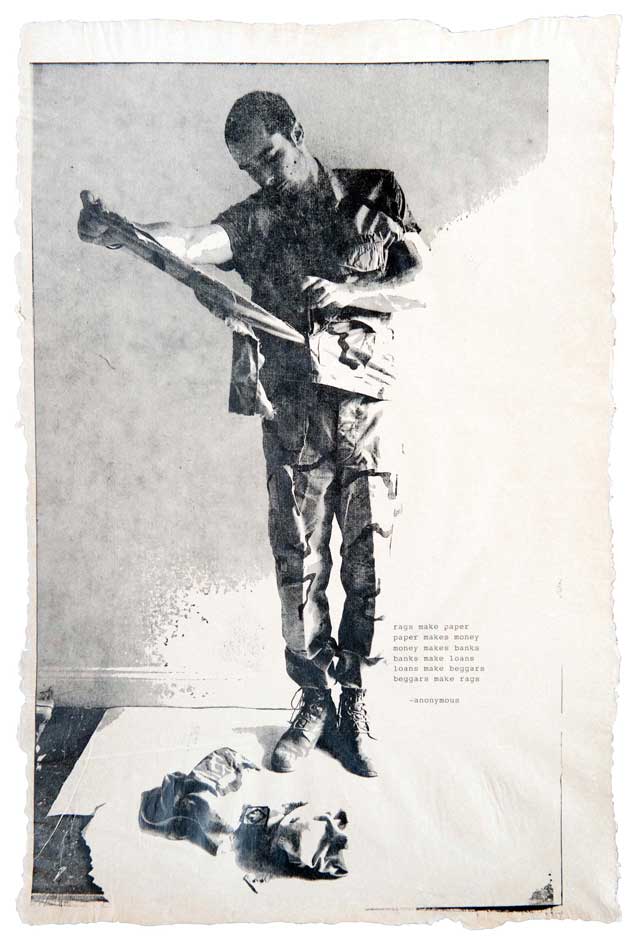
NEW ROADS — When viewed completely detached from context, the papers hanging on the walls over at the current New Roads School's art exhibit are calming.
Light green poster-sized papers sit next to lighter green papers. Larger orange, blue, and green papers, imprinted with American flags, cover the red walls.
"When I walk by these I get chills," said New Road's Visual Arts Chair Marcia Moore. "This one in particular really sets me off."
She's pointing to a self portrait of the artist, Drew Cameron, cutting himself out of his military uniform. The paper on which it is printed, a dusty brown color, was made with the fibers of uniforms. The orange American flag was made with prison uniforms, the blue one with Navy uniforms.
Printed in a haunting font on the green poster-sized papers (also made with uniforms) are words he's collected from veterans.
"I won't wear them again," reads one. Another is completely blank.
Cameron's exhibition, "Combat Paper Project," is on display at the Capshaw-Spielberg Center for Arts and Education Justice building through mid-March. The Iraq war veteran who left the military in 2006 will hold a paper-making workshop for students next month. Cameron will discuss his work in a gallery talk open to the public at 7 p.m. on March 5.
Moore reached out to Cameron because his work aligns with the school's mission statement, which includes keeping students connected with global issues.
"I took my art history class to see the exhibit and while they understand how it's made I think it's hard to relate to where they actually come from," she said. "It's hard to understand that these are people who volunteer to make this sacrifice."
For Cameron, that's a part of the project.
"One of the points I'm trying to make is that I don't want it to be shrouded in myth," he said. "I want everyone participating to feel like they have agency in the story."
He teaches veterans how to make paper with their uniforms, which are cut up, beaten into pulp, and formed into sheets.
"I want to get to some of what is encoded into the uniform itself," he said. "How does it relate to their experiences? Why is it meaningful to a civilian? Does it relate to their family? Do they know someone in the uniform?"
What is encoded into the uniform for him, he said, is not important.
"I'm a facilitator," he said. "I'm more interested in their interpretation of the uniform than mine. What I think doesn't matter."
But his work on the paper, the work that's on display now at New Roads, is often inspired by his relationship to the uniform.
"It's been such a huge and meaningful part of my life," he said. "I grew up around the military. I've served in war. It's my life's work. There are a lot of things that are wrapped into it. It is an endless discovery process."
The discovery process led him back beyond the wars, back to before the uniforms were uniforms, back to when they were just cotton. Most of them are made in the United States, sometimes in jails, he said.
Cameron seems obsessed with following the uniform fiber from its beginnings in the cotton fields to his studio, where it becomes paper — a medium for passing messages.
"The uniforms often become inhabitants of closets or boxes in the attic," he said. "Reshaping that association of subordination, of warfare and service, into something collective and beautiful is our inspiration."
dave@www.smdp.com

